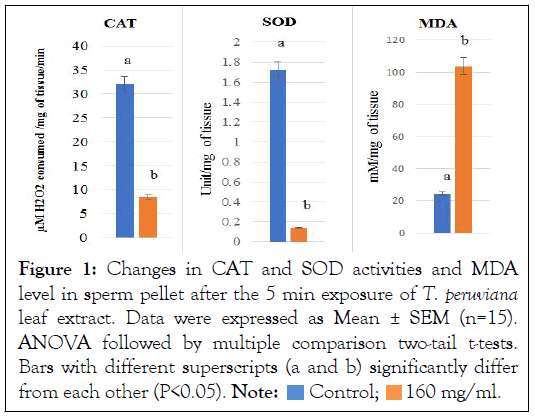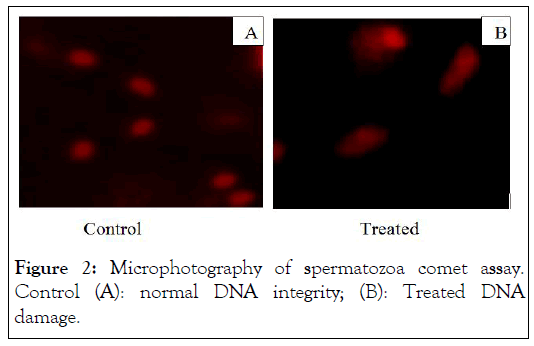Andrology-Open Access
Open Access
ISSN: 2167-0250
+44 1300 500008
ISSN: 2167-0250
+44 1300 500008
Short Communication - (2022)
Spermicidal agents from herbal sources are more effective and safer. Thevetia peruviana is an herb that has effective spermicidal activity by altering motility, viability of healthy human spermatozoa. Catalase and superoxide dismutaseT. peruviana activities were decreased but MDA levels elevated significantly in sperm cells after the 5 min treatment of hydromethanolic (2:3) extract of T. peruviana at 160 mg/ml dose. It also alters the sperm DNA integrity that is measured by comet assay.
Motility; Viability; Spermatozoa; DNA
Population explosion is the global burden. To control the population different contraceptive methods have been applied by the male and female candidates but they have several side effects [1], among them hormonal imbalance, ulceration, inflammations in genital organ, loss of libido and other problem are included [2]. Scientists are engaged to search out safe and effective contraceptive from herbal source. Thevetia peruviana leaf extract have spermicidal efficacy that we have reported earlier [3]. Whether this spermicidal efficacy is due to the imposition of oxidative stress by the plant extract or it has any direct effect on sperm DNA integrity to search out that this study has been conducted.
Semen collection and analytical procedure
Fifteen normospermic semen samples were collected from 20-30 years old healthy donor after screening. This study approved by institutional ethical committee (Reg No. 2013/GO/Re/S/18/ CPCSEA, DOR-01/05/18) [3].
Experimental design
Hydro-methanolic extract of T. peruviana has been prepared according to standard method. The extract was taken at 160 mg / ml DW as it is the most effective dose and mixed with semen at 1:1 ratio. The mixture was incubated at 37°C for 5 min. Sperm motility, viability, catalase (CAT), superoxide dismutase (SOD) activities and malondialdehyde (MDA) levels were assessed in sperm pellet. Comet assay was performed in control and treated semen sample for the assessment of DNA breakage by green excitation filter of fluorescent microscope (Carl Zeiss Axio scope A1 optical microscope) at 400X [3-9].
Sperm motility and viability were significantly decreased in 160 mg/ml T. peruviana administered group by 94.57% and 93.93% initially (20s) but after 5 min and 10 min of extract treatment complete immobilized and nonviable sperm are found (Table 1).
| Motility (%) | Viability (%) | |||
|---|---|---|---|---|
| Control | T. peruviana treated (160 mg/ml) | Control | T. peruviana treated (160 mg/ml) | |
| 0 min | 82.57 ± 0.32a | 4.49 ± 0.09b | 83.27 ± 0.29a | 5.06 ± 0.21b |
| 5 min | 79.87 ± 0.34a | 0.29 ± 0.01b | 80.62 ± 0.49a | 0.29 ± 0.01b |
| 10 min | 77.86 ± 0.24a | 0 | 78.53 ± 0.37a | 0 |
Note: Data represented as Mean ± SEM, n=15. ANOVA followed by two-tail t-test. Different superscripts (a and b) in each vertical column were significantly differ from each other (P<0.05).
Table 1: Effect of hydro-methanolic extract of T. peruviana leaves on sperm motility and viability.
Activities of CAT and SOD were significantly decreased but MDA level was elevated in T.peruviana treated group after 5 min of extract treatment (Figure 1).

Figure 1: Changes in CAT and SOD activities and MDA
level in sperm pellet after the 5 min exposure of T. peruviana leaf extract. Data were expressed as Mean ± SEM (n=15).
ANOVA followed by multiple comparison two-tail t-tests.
Bars with different superscripts (a and b) significantly differ
from each other (P<0.05).  .
.
Significant number of DNA damaged spermatozoa (91.45%) were found in T. peruviana extract treated group in respect to control (9.61%) after the 5 min exposure (Figure 2).

Figure 2: Microphotography of spermatozoa comet assay. Control (A): normal DNA integrity; (B): Treated DNA damage.
Sperm motility and viability are important screening test to indicate infertility status of an individual. Both these parameters were significantly decreased after immediate exposure of T. peruviana at 160 mg dose. This is due to the damage of sperm membrane integrity that we have established earlier, as well as significant DNA damage in spermatozoa measured by comet assay [3,10]. This DNA damage is caused by excess oxidative stress imposition that is also associated with imbalance between ROS production and anti-oxidant defense system [10,11]. CAT and SOD enzyme activities in sperm pellet were decreased but MDA level was elevated after 5 min exposure of T. peruviana extract.
This indicates the active ingredient(s) present in the T. Peruviana leaf extract damage the sperm cell directly by the generation of free radical that leads to DNA damage. In summary, the present study has shown that the T. peruviana leaf extract have potential spermicidal efficacy by modulating sperm motility, viability and sperm DNA integrity by generation of oxidative stress and alteration of antioxidant defense mechanism.
[CrossRef] [Google Scholar] [Pubmed]
[CrossRef] [Google Scholar] [Pubmed]
[CrossRef] [Google Scholar] [Pubmed]
[Google Scholar] [Pubmed]
[Google Scholar] [Pubmed]
[CrossRef] [Google Scholar] [Pubmed]
[CrossRef] [Google Scholar] [Pubmed]
[CrossRef] [Google Scholar] [Pubmed]
Citation: Mallick C, Mondal P (2022) Spermicidal Efficacy of Thevetia peruviana Leaves by Modulating DNA Damage and Antioxidant Status. Andrology. S2:001.
Received: 22-Apr-2022, Manuscript No. ANO-22-17076; Editor assigned: 25-Apr-2022, Pre QC No. ANO-22-17076 (PQ); Reviewed: 09-May-2022, QC No. ANO-22-17076; Revised: 16-May-2022, Manuscript No. ANO-22-17076 (R) ; Published: 23-May-2022 , DOI: 10.35248/2167-0250.22.S2.001
Copyright: © 2022 Mallick C, et al. This is an open-access article distributed under the terms of the Creative Commons Attribution License, which permits unrestricted use, distribution, and reproduction in any medium, provided the original author and source are credited.
Sources of funding : NO